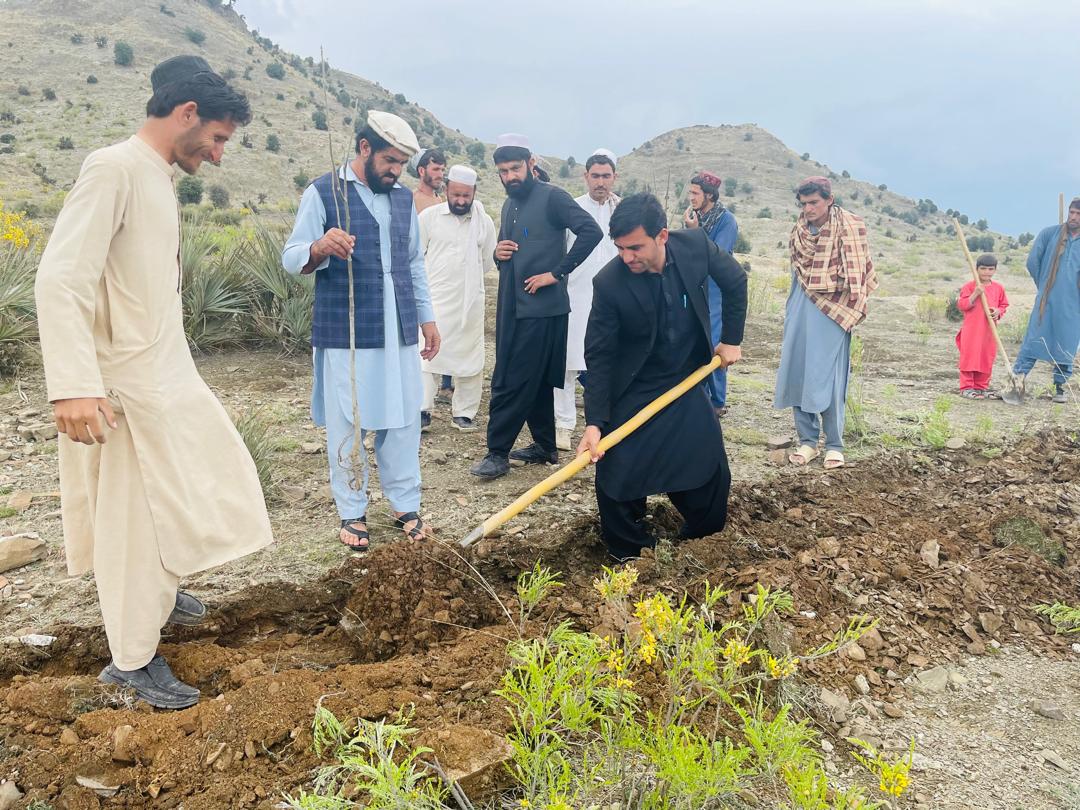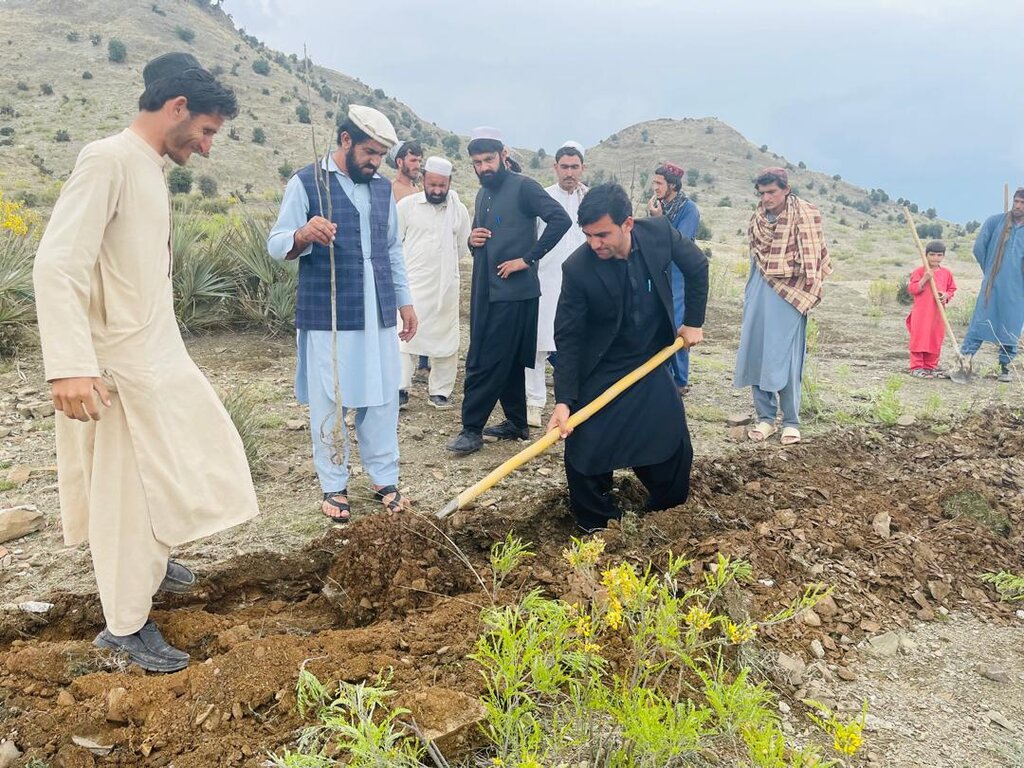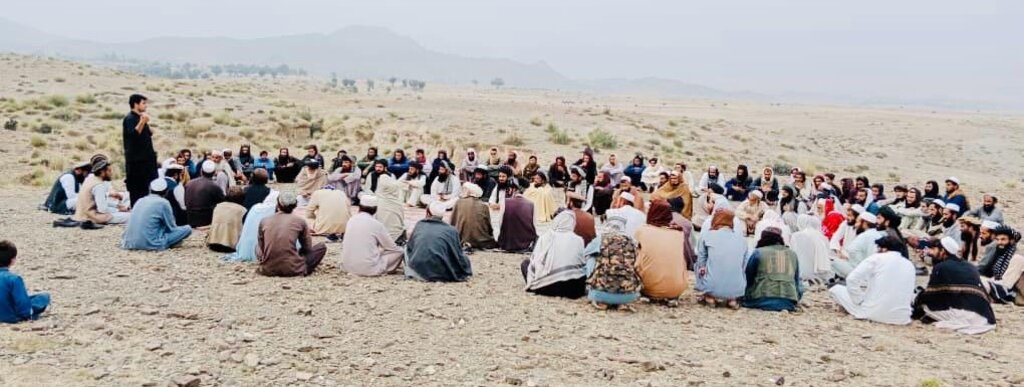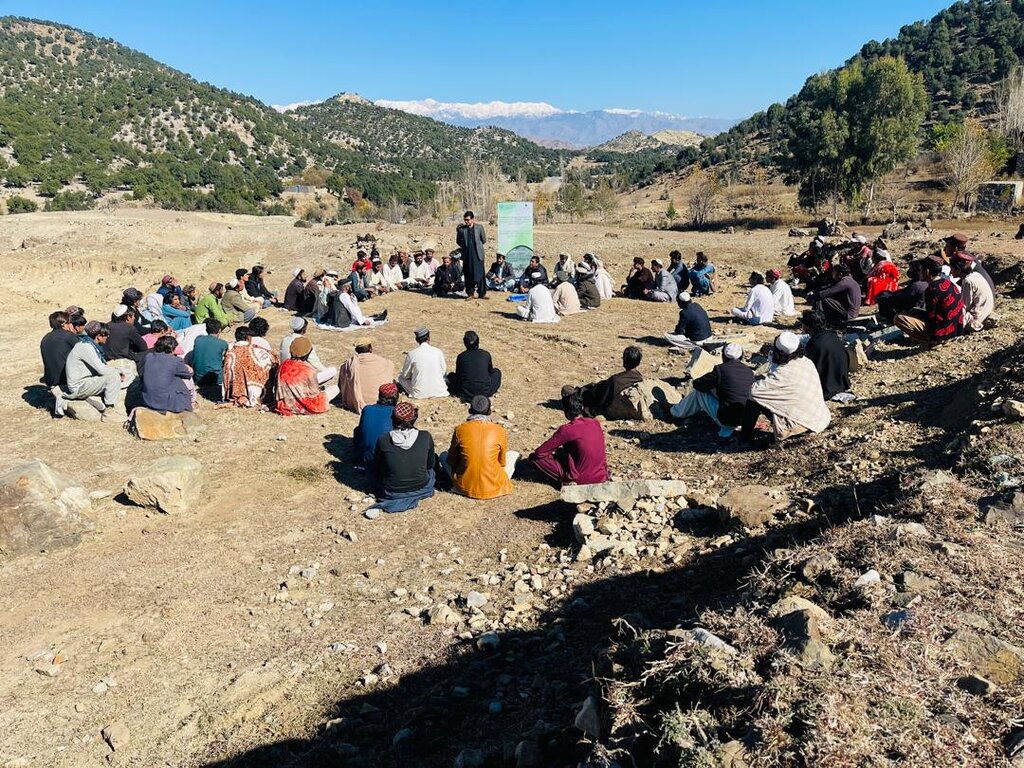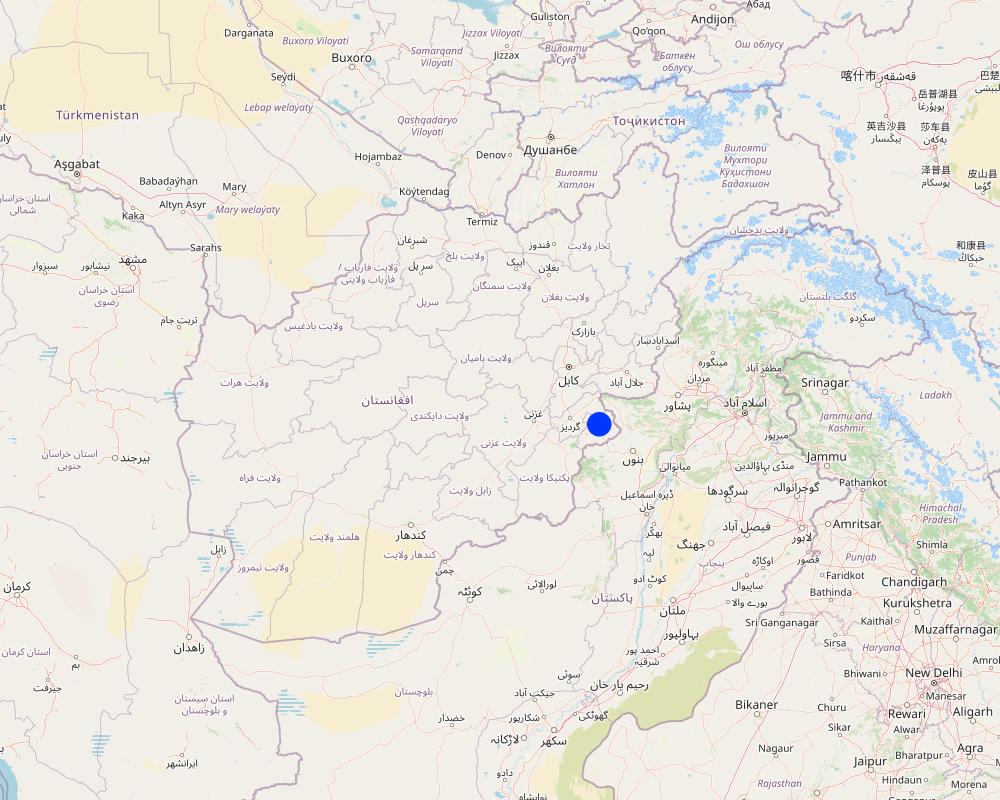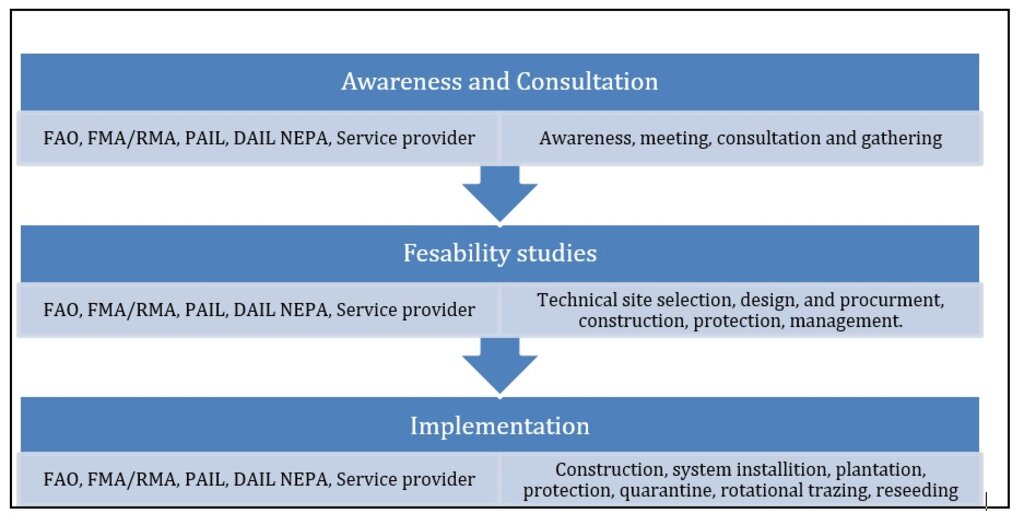Community based reforestation initiatives to restore degraded forest and rangeland [อัฟกานิสถาน]
- ผู้สร้างสรรค์:
- การอัพเดท:
- ผู้รวบรวม: Mohammad Aslam Hasand
- ผู้เรียบเรียง: Megha bajaj, Afghanistan Safi, Mohammad Arif
- ผู้ตรวจสอบ: Rima Mekdaschi Studer, Illias Animon, Muhammad Ishaq Safi
د ټولنې پر مټ د بيا رغنيز نوښت له لارې د تخريب شوي ځنګل او څړځای رغول
approaches_7470 - อัฟกานิสถาน
- บทสรุปทั้งหมดในรูปแบบของ PDF
- บทสรุปทั้งหมดในรูปแบบของ PDF เพื่อพิมพ์
- บทสรุปทั้งหมดในรูปหน้าเว็บ
- บทสรุปทั้งหมด (ไม่มีการจัดเรียง)
- Community based reforestation initiative to restore degraded forest and rangeland.: 6 มีนาคม 2025 (inactive)
- Community based reforestation initiative to restore degraded forest and rangeland.: 24 มีนาคม 2025 (inactive)
- Community based reforestation initiative to restore degraded forest and rangeland.: 2 พฤษภาคม 2025 (inactive)
- Community based reforestation initiatives to restore degraded forest and rangeland: 7 พฤษภาคม 2025 (public)
ดูส่วนย่อย
ขยายทั้งหมด ย่อทั้งหมด1. ข้อมูลทั่วไป
1.2 รายละเอียดที่ติดต่อได้ของผู้รวบรวมและองค์กรที่เกี่ยวข้องในการประเมินและการจัดเตรียมทำเอกสารของแนวทาง
ผู้เชี่ยวชาญ SLM:
ผู้ใช้ที่ดิน:
Haleem Bakhtawer Khan
0765983451
bakhtawerkhan.halim@gmail.com
Sapari Forest and Rangeland Management Association
Sapari, Sabari, Khost, Afghanistan
อัฟกานิสถาน
ชื่อของโครงการซึ่งอำนวยความสะดวกในการทำเอกสารหรือการประเมินแนวทาง (ถ้าเกี่ยวข้อง)
Community-based sustainable land and forest management in Afghanistanชื่อของโครงการซึ่งอำนวยความสะดวกในการทำเอกสารหรือการประเมินแนวทาง (ถ้าเกี่ยวข้อง)
FAO Afghanistan (FAO Afghanistan) - อัฟกานิสถาน1.3 เงื่อนไขที่เกี่ยวข้องกับการใช้ข้อมูลที่ได้บันทึกไว้ผ่านทาง WOCAT
วันที่เก็บรวบรวมข้อมูล (ภาคสนาม):
15/12/2024
ผู้รวบรวมและวิทยากรหลักยอมรับเงื่อนไขเกี่ยวกับการใช้ข้อมูลที่ถูกบันทึกผ่านทาง WOCAT:
ใช่
2. คำอธิบายของแนวทาง SLM
2.1 การอธิบายแบบสั้น ๆ ของแนวทาง
Community-driven reforestation initiative that involves awareness-raising, capacity building, feasibility analysis, and collaboration among various stakeholders to address land degradation and promote sustainable forest and rangeland management
2.2 การอธิบายอย่างละเอียดของแนวทาง
การอธิบายอย่างละเอียดของแนวทาง:
The main aim of this approach is to contribute to ecosystem restoration, biodiversity conservation and carbon sequestration through community awareness-raising, consultation and capacity building, feasibility analysis, site selection as well as resources mobilization for reforestation initiatives in Khost, Afghanistan.
This community driven initiative emerged, bringing together land users, forest and rangeland management associations, environmental experts, specialists and policymakers from various departments like Provincial Agriculture, Irrigation and Livestock, National Environment Projection Agency, District Agriculture, Irrigation and Livestock to heal the land, restore the forests, and rebuild the connection between people and nature.
The first step was to understand the root causes of degradation, followed by a detailed assessment to identify areas most in need of intervention. Priority was given to barren land stripped by erosion, degraded forests areas, and nutrient-depleted soils. The community incorporated traditional ecological knowledge shared by local elders, who recalled periods when the valley supported dense vegetation and thriving ecosystems. This was combined with modern ecological practices to develop a comprehensive restoration plan that balanced traditional knowledge with scientific innovation. The approach ensures awareness raising of the rural community, and knowledge and information enhancement on restoration of degraded forest and rangeland through reforestation initiatives in Khost, Afghanistan.
Specific objectives of the approach are:
1. To enhance the knowledge and awareness of rural communities in Khost, Afghanistan on restoring degraded forests and rangelands, including through public awareness, campaigns, community mobilization, consultations, and feasibility assessments, and mobilizing resources.
2. Involve key stakeholders actively in restoration, including Provincial Agriculture Irrigation and Livestock (PAIL), Provincial National Environmental Protection Agency (NEPA), District Agriculture Irrigation and Livestock department (DAIL), Forest and Rangeland Management Association (FM/RM Association).
3. To enhance the capacity of Forest and Rangeland Management Association (FM/RM Associations) and local communities for effective restoration of degraded forests and rangelands through reforestation initiatives in Khost, Afghanistan.
4. To restore degraded forests and rangelands by enhancing knowledge, skills, and resources for sustainable management. This includes empowering the FM/RM Associations by improving its members’ understanding, skills, capacity, and active participation in conservation and restoration efforts.
5. To restore habitat for strengthening biodiversity conservation.
2.3 รูปภาพของแนวทาง
ข้อสังเกตทั่วไปเกี่ยวกับรูปภาพ:
Public awareness and community mobilization – engaging local communities, tribal elders, and stakeholders in decision-making, social participation as well as capacity building – training communities on sustainable practices and policy enforcement.
2.5 ประเทศ ภูมิภาค หรือสถานที่ตั้งที่ได้นำแนวทางไปใช้
ประเทศ:
อัฟกานิสถาน
ภูมิภาค/รัฐ/จังหวัด: :
Khost
ข้อมูลเฉพาะเพิ่มเติมของสถานที่ตั้ง:
Sapari forest, Sabari district, Khost, Afghanistan
Map
×2.6 วันที่เริ่มต้นและสิ้นสุดของแนวทาง
ระบุปีที่เริ่ม:
2023
การสิ้นสุดลง (ถ้าแนวทางไม่ได้ใช้อีกต่อไป):
2026
2.7 ประเภทของแนวทาง
- ใช้โครงงานหรือแผนงานเป็นฐาน
2.8 เป้าหมายหรือวัตถุประสงค์หลักของแนวทาง
To enhance the capacity of FM/RM Associations and local communities for adopting the technology on restoration of degraded forests and rangelands through reforestation initiatives in Khost.
-To restore habitat for strengthening biodiversity conservation.
-To promote the conversion of unproductive lands to productive lands.
-To empower local communities to replicate and scale up similar initiatives.
2.9 เงื่อนไขที่เอื้ออำนวยหรือเป็นอุปสรรคต่อการนำเทคโนโลยีภายใต้แนวทางนี้ไปปฏิบัติใช้
บรรทัดฐานและค่านิยมทางสังคม วัฒนธรรม ศาสนา
- เอื้ออำนวย
Social gathering, social participation for sapling plantation, information sharing among community members.
การมีไว้ให้หรือการเข้าถึงแหล่งการเงินและบริการ
- เอื้ออำนวย
There is availability and access to financial resource and services, because all the financial support is directly transferred to community.
การจัดตั้งระดับองค์กร
- เอื้ออำนวย
FM/RM Associations are established to improve forest and rangeland management.
การร่วมมือหรือการทำงานประสานกันของผู้ลงมือปฏิบัติ
- เอื้ออำนวย
Other projects are collaborating with FM/RM Associations due to their status as a legal entity
กรอบแนวทางในการดำเนินการด้านกฎหมาย (การถือครองที่ดิน สิทธิในการใช้ที่ดินและน้ำ)
- เป็นอุปสรรค
The legal framework for land tenure and land and water use rights exists; they are, however, not properly implemented.
ความรู้เกี่ยวกับ SLM การเข้าถึงการสนับสนุนด้านเทคนิค
- เอื้ออำนวย
Community members have access to SLM knowledge through awareness raising, training and workshops offered
ปริมาณงานที่ทำได้ กำลังคนที่มีให้
- เอื้ออำนวย
Workload of FM/RM Associations during plantation campaign, protection and general management.
3. การมีส่วนร่วมและบทบาทของผู้มีส่วนได้ส่วนเสียที่เกี่ยวข้อง
3.1 ผู้มีส่วนได้ส่วนเสียที่เกี่ยวข้องในแนวทางนี้และบทบาท
- ผู้ใช้ที่ดินระดับท้องถิ่นหรือชุมชนระดับท้องถิ่น
Local community and farmers
Land users, local community members: Mobilizations, awareness, social participation as well as self-contribution.
- องค์กรที่ขึ้นอยู่กับชุมชน
Forest and Rangeland Management Associations (FM/RM Associations)
FM/RM Associations: decision making, awareness, mobilization, capacity building and social structure for self and in kind contribution.
- ผู้เชี่ยวชาญ SLM หรือที่ปรึกษาการเกษตร
FAO specialist
Technical assistance
- ภาคเอกชน
Construction company
Construction, mechanical work and installation of system in including facilitation
- รัฐบาลระดับท้องถิ่น
Provincial Agriculture and Livestock (PAIL), District Agriculture Irrigation and Livestock (DAIL), National Environment Protection Agency (NEPA)
Facilitation for the implementation of project
- องค์การระหว่างประเทศ
FAO (Food and Agriculture Organization of the United Nations)
Implementation of the GEF-funded project and technical assistance
ถ้ามีผู้มีส่วนได้ส่วนเสียหลายคนที่เกี่ยวข้องให้ระบุหน่วยงานตัวแทน:
UNFAO (Food and Agriculture Organization of the United Nations)
3.2 การเกี่ยวข้องของผู้ใช้ที่ดินระดับท้องถิ่นหรือชุมชนระดับท้องถิ่นในช่วงต่างๆของแนวทาง
| ความเกี่ยวข้องของผู้ใช้ที่ดินระดับท้องถิ่นหรือชุมชนระดับท้องถิ่น | ระบุผู้ที่มีส่วนเกี่ยวข้องและอธิบายกิจกรรม | |
|---|---|---|
| การริเริ่มหรือการจูงใจ | ระดมกำลังด้วยตนเอง | FM/RM Association: mobilization, awareness raising and general management through social participation. |
| การวางแผน | ปฏิสัมพันธ์ | FM/RM Association: jointly with community by developing of Community Based Natural Resources Management (CBNRM) plan. |
| การดำเนินการ | ปฏิสัมพันธ์ | FM/RM Association: jointly with community provided labour, facilitation, coordination and consultation as well as supporting all the activities during implementation period as self and community in kind contribution. |
| การติดตามตรวจสอบหรือการประเมินผล | ปฏิสัมพันธ์ | FM/RM Association: members are key stakeholders of the participatory monitoring and evaluation process. |
3.3 แผนผังแสดงขั้นตอนการทำงาน (ถ้ามี)
คำอธิบาย:
"The Restoration of Degraded Forest and Rangeland Approach" focuses on reviving degraded forest, rangeland and generally ecosystems through sustainable reforestation initiatives. This approach involves: Identifying degraded areas and developing restoration initiatives, involving local communities in decision-making and capacity-building, planting native species, improving soil health, and adopting sustainable land management techniques, regularly assessing progress, addressing challenges, and ensuring long-term sustainability.
This integrated approach helps restore forest and rangeland, biodiversity, improve water retention, prevent soil erosion, and enhance local livelihoods.
Acronyms and Key Concepts:
Food and Agriculture Organization of the United Nations (FAO)
Provincial Agriculture, Irrigation and Livestock (PAIL)
District Agriculture, Irrigation and Livestock (DAIL)
Forest and Rangeland Management Association (FM/RM Association)
Service providers are referred to different construction and logistics’ companies and contractors.
ผู้เขียน:
Mohammad Aslam Hasand
3.4 การตัดสินใจเลือกใช้เทคโนโลยี SLM
ระบุผู้ที่ทำการตัดสินใจเลือกเทคโนโลยีมากกว่าหนึ่งวิธีไปปฏิบัติใช้:
- ผู้ลงมือปฏิบัติที่เกี่ยวข้องทั้งหมดในฐานะที่เป็นส่วนรวมของแนวทาง
การอธิบาย:
It was a participatory feasibility study that involved joint decision making
ระบุว่าการตัดสินใจตั้งอยู่บนพื้นฐานของ:
- การประเมินความรู้ SLM ที่ได้ทำการบันทึกไว้เป็นอย่างดี (การใช้ข้อมูลในการตัดสินใจ)
4. การสนับสนุนด้านเทคนิค การสร้างขีดความสามารถ และการจัดการด้านความรู้
4.1 การสร้างขีดความสามารถ / การอบรม
ได้มีการจัดอบรมให้แก่ผู้ใช้ที่ดินหรือผู้มีส่วนได้ส่วนเสียคนอื่น ๆ หรือไม่:
ใช่
ให้ระบุว่าใครเป็นผู้ได้รับการอบรม:
- ผู้ใช้ที่ดิน
- เจ้าหน้าที่ภาคสนาม / ที่ปรึกษา
รูปแบบการอบรม:
- กำลังดำเนินการ
- เกษตรกรกับเกษตรกร
- จัดการประชุมสู่สาธารณชน
หัวข้อที่พูด:
SLM/SFM practices, awareness, mobilization, quarantine, rotational grazing, biodiversity conservation, climate change, CBNRM plan, participatory moinotoring, operation of the system and general management of natural resources.
4.2 การบริการให้คำแนะนำ
ผู้ใช้ที่ดินมีการเข้าถึงการรับบริการให้คำปรึกษาหรือไม่:
ใช่
ระบุว่ามีบริการให้คำปรึกษาหรือไม่:
- ไปเยี่ยมชมสถานที่
การอธิบาย/แสดงความคิดเห็น:
Operating the irrigation system, sapling transplantation, quarantine, rotational grazing and general management.
4.3 การเสริมความแข็งแกร่งให้กับสถาบัน (การพัฒนาองค์กร)
สถาบันได้รับการจัดตั้งขึ้นมาหรือเสริมความแข็งแกร่งโดยแนวทางนี้หรือไม่:
- ใช่ ปานกลาง
ระบุระดับของสถาบันที่ได้รับการเสริมความแข็งแกร่งหรือจัดตั้งขึ้นมา:
- ท้องถิ่น
อธิบายถึงสถาบัน บทบาทและความรับผิดชอบ สมาชิก เป็นต้น:
FM/RM Association
ระบุประเภทของการให้ความช่วยเหลือสนับสนุน:
- ด้านการเงิน
- การสร้างขีดความสามารถ / การอบรม
- อุปกรณ์
ให้รายละเอียดเพิ่มเติม :
Signed LoA for implementation and cost contribution, on site awareness raising, social mobilization, holding gathering and workshops and provided construction materials and tools for nursery establishment.
4.4 การติดตามตรวจสอบและประเมินผล
การติดตามตรวจสอบและประเมินผลเป็นส่วนหนึ่งของแนวทางหรือไม่:
ใช่
ความคิดเห็น:
FM/RM Association has the responsibility to perform monitoring of all activities in Sapari forest of Sabari district of Khost province.
ถ้าตอบว่าใช่ แสดงว่าการจัดเตรียมเอกสารนี้มุ่งหวังที่จะเอาไปใช้สำหรับการติดตามตรวจสอบและประเมินผลใช่หรือไม่:
ใช่
ความคิดเห็น:
Monitoring is a part of the Community-based NRM plan.
4.5 การวิจัย
การวิจัยเป็นส่วนหนึ่งของแนวทางหรือไม่:
ไม่ใช่
5. การสนับสนุนด้านการเงินและวัสดุอุปกรณ์
5.1 ระบุงบประมาณประจำปีสำหรับแนวทาง SLM นี้
ถ้าหากว่างบประมาณประจำปีไม่เป็นที่ทราบแน่นอน ให้ระบุช่วงลงไป:
- 10,000-100,000
แสดงความคิดเห็น (แหล่งของการระดมทุน ผู้บริจาคคนสำคัญ):
Financial support is provided by the FAO-GEF project and in-kind contributions are from the community. In-kind contribution covers providing physical space or facilities to support the project, coordination, consultation and general facilitation, and human resources for restoration, patrolling, quarantine, and other community relevant activities. Hence, 80 percent of the financial support is provided by the FAO-GEF project and 20 percent by the community (as in-kind support).
5.2 การสนับสนุนด้านการเงิน / วัสดุอุปกรณ์ให้แก่ผู้ใช้ที่ดิน
ผู้ใช้ที่ดินได้รับการสนับสนุนด้านการเงิน / วัสดุอุปกรณ์ไปปฏิบัติใช้เทคโนโลยีหรือไม่:
ใช่
ถ้าใช่ ให้ระบุประเภทของการสนับสนุน เงื่อนไขและผู้จัดหามาให้:
Technical support and livelihood packages including solar cooker, chopper machine, dairy toolkit, walnut cracker, construction material for reservoirs (cement, sand, stone, pipes), material for nursery establishment and saplings were provided.
5.3 เงินสนับสนุนสำหรับปัจจัยนำเข้า (รวมถึงแรงงาน)
- ไม่มี
ถ้าแรงงานโดยผู้ใช้ที่ดินเป็นปัจจัยนำเข้าที่มีอยู่มากมาย ระบุด้วยว่าเนื่องจาก:
- สมัครใจ
5.4 เครดิต
มีการจัดหาเครดิตมาให้ภายใต้แนวทาง SLM หรือไม่:
ไม่ใช่
5.5 แรงจูงใจหรือเครื่องมืออื่น ๆ
แรงจูงใจหรือเครื่องมืออื่น ๆ ได้ถูกนำไปใช้ส่งเสริมการใช้เทคโนโลยี SLM หรือไม่:
ใช่
ถ้าใช่ ระบุ:
Training workshops and other capacity building programmes, field day tour, social gathering as well as site visits by communities.
6. การวิเคราะห์ผลกระทบและการสรุป
6.1 ผลกระทบของแนวทาง
ทำให้ผู้ใช้ที่ดินระดับท้องถิ่นมีอำนาจขึ้น ปรับปรุงการเข้าร่วมของผู้มีส่วนได้ส่วนเสียให้ดีขึ้นหรือไม่:
- ไม่ใช่
- ใช่ เล็กน้อย
- ใช่ ปานกลาง
- ใช่ อย่างมาก
Capacity building, empowering of Forest and rangeland management associations (FM/RM Associations)
ช่วยในการตัดสินใจโดยดูจากหลักฐาน ได้หรือไม่:
- ไม่ใช่
- ใช่ เล็กน้อย
- ใช่ ปานกลาง
- ใช่ อย่างมาก
Monitoring and participatory assessment skills were improved under the approach allowing to assess results and impacts and collecting evidence for decision-making
ช่วยให้ผู้ใช้ที่ดินนำเอาเทคโนโลยี SLMไปใช้และบำรุงรักษาสภาพไว้ได้หรือไม่:
- ไม่ใช่
- ใช่ เล็กน้อย
- ใช่ ปานกลาง
- ใช่ อย่างมาก
Consultation meetings, workshops, training, on job practical work and capacity building for better implementation of the technology.
ปรับปรุงความร่วมมือกันและการดำเนิน งานของ SLM ได้อย่างมีประสิทธิผลหรือไม่:
- ไม่ใช่
- ใช่ เล็กน้อย
- ใช่ ปานกลาง
- ใช่ อย่างมาก
FM/RM Associations and local community contribution, particularly providing of labour during plantation campaigns, protection and maintenance.
ระดมกำลังหรือปรับปรุงการเข้าถึงแหล่ง เงินทุนสำหรับการดำเนินการ SLM หรือไม่:
- ไม่ใช่
- ใช่ เล็กน้อย
- ใช่ ปานกลาง
- ใช่ อย่างมาก
Financial resources accessed according to the terms specified in the LoA.
ปรับปรุงความรู้และความสามารถของผู้ใช้ที่ดินในการดำเนินการ SLM หรือไม่:
- ไม่ใช่
- ใช่ เล็กน้อย
- ใช่ ปานกลาง
- ใช่ อย่างมาก
FAO technical staff conducted various trainings, workshop as well as awareness raising session regarding improving of land users’ capacity for better implementation of the SLM.
ปรับปรุงความรู้และความสามารถของผู้มีส่วนได้ส่วนเสียคนอื่น ๆ ให้ดีขึ้นหรือไม่:
- ไม่ใช่
- ใช่ เล็กน้อย
- ใช่ ปานกลาง
- ใช่ อย่างมาก
Local governmental institutions like provicial and district Agriculture, Irrigation and Livestock (PAIL/DAIL) departements,FM/RM Associations and local community knowledge has been improved on SLM/SFM.
ทำให้ผู้ใช้ที่ดินระดับท้องถิ่นมีอำนาจขึ้น ปรับปรุงการเข้าร่วมของผู้มีส่วนได้ส่วนเสียให้ดีขึ้นหรือไม่:
- ไม่ใช่
- ใช่ เล็กน้อย
- ใช่ ปานกลาง
- ใช่ อย่างมาก
Collaboration among FM/RM Associations, local community, governmental institutions and other stakeholders has been strengthened.
ช่วยบรรเทาความขัดแย้งหรือไม่:
- ไม่ใช่
- ใช่ เล็กน้อย
- ใช่ ปานกลาง
- ใช่ อย่างมาก
FM/RM Associations and local community facilitated implementation of the project on communal land as well as mitigated all sort of conflicts regarding protection, quarantine, rotational grazing and other sections.
ปรับปรุงความทัดเทียมกันด้านเพศและให้อำนาจแก่ผู้หญิงและเด็กผู้หญิงหรือไม่:
- ไม่ใช่
- ใช่ เล็กน้อย
- ใช่ ปานกลาง
- ใช่ อย่างมาก
Women were actively involved in all project activities; some livelihood programs have been targeted at women and girls.
ส่งเสริมให้เยาวชนหรือบุตรหลานของผู้ใช้ที่ดินให้เข้าร่วมใน SLM:
- ไม่ใช่
- ใช่ เล็กน้อย
- ใช่ ปานกลาง
- ใช่ อย่างมาก
Through awareness raising, workshop, training, farmer field schools, brochures and other visibility materials encouraged young people or next generation to engage in SLM.
Awareness raising sessions, trainings and workshops enhanced the knowledge of Forest and Rangeland Management Association (FMA/RMA) members and local community regarding sustainable of natural resource management.
ปรับปรุงความสามารถของผู้ใช้ที่ดินในการปรับตัวให้เข้ากับการเปลี่ยนแปลงของสภาพภูมิอากาศหรือสภาพที่รุนแรงและภัยพิบัติหรือไม่:
- ไม่ใช่
- ใช่ เล็กน้อย
- ใช่ ปานกลาง
- ใช่ อย่างมาก
Improved water harvesting, controlled land degradation, planted saplings, prevented flood splash and water erosion which improved land users’ resilience to climatic changes/extremes and disaster.
นำไปสู่โอกาสในการจ้างงาน รายได้หรือไม่:
- ไม่ใช่
- ใช่ เล็กน้อย
- ใช่ ปานกลาง
- ใช่ อย่างมาก
Short employment created for local community.
6.2 แรงจูงใจหลักของผู้ใช้ที่ดินเพื่อที่จะนำ SLM ไปปฏิบัติใช้
- การผลิตที่เพิ่มขึ้น
Increased production of fodder from trees and grasses.
- การเสื่อมของที่ดินลดลง
Improved soil cover reduces water-induced erosion, helping to preserve soil fertility. Water harvesting captures surface runoff for irrigation and contributes to groundwater recharge.
- ความเสี่ยงของภัยพิบัติลดลง
- ภาระงานลดลง
Through active social participation.
- กฎและระเบียบ (ค่าปรับ) หรือการบังคับใช้
Enforcement of customary roles and regulations among the community, enhance tribal and traditional structures for facilitation and implementation of the technology.
- ความรู้และทักษะ SLM ที่เพิ่มพูนขึ้น
The consciousness of local community has been enhanced regarding SLM.
- การบรรเทาด้านความขัดแย้ง
The establishment of FM/RM Associations helped mitigate conflicts and facilitated smoother project implementation.
6.3 ความยั่งยืนของกิจกรรมของแนวทาง
ผู้ใช้ที่ดินสามารถทำให้สิ่งต่างๆ ที่ได้ปฏิบัติใช้โดยแนวทางนี้ยั่งยืนได้หรือไม่ (โดยไม่มีการสนับสนุนจากภายนอก):
- ใช่
ถ้าตอบว่าใช่ ให้อธิบายว่าอย่างไร :
Land users can sustain these efforts because their capacity has been strengthened, they have a sense of local ownership, and adaptive tribal management systems are in place, ensuring the long-term benefits of restoration for future generations.
6.4 จุดแข็งและข้อได้เปรียบของแนวทาง
| จุดแข็ง / ข้อได้เปรียบของแนวทางในทัศนคติของผู้ใช้ที่ดิน |
|---|
| Awareness, consciousness and knowledge on natural resources management of communities enhanced through workshops and trainings. |
| Increased availability of natural resources for better livelihoods of communities. |
| With increased community contribution, local efforts will support the protection and sustainable management of resources even after external support ends. |
| จุดแข็ง / ข้อได้เปรียบของแนวทางในทัศนคติของผู้รวบรวมหรือวิทยากรหลัก |
|---|
| This approach revives ecosystems by reintroducing native plant and animal species, supporting increased biodiversity and creating habitats for wildlife. |
| This approach improves ecosystem resilience, supports sustainable livelihoods, and promotes climate change adaptation. Restoration ensures long-term sustainability while addressing environmental, economic, and cultural needs. |
| The established FM/RM Associations have become the recognized legal bodies for managing forests, rangelands, and other natural resources. They will be responsible for ensuring sustainability and long-term protection after the project. |
6.5 จุดอ่อน / ข้อเสียเปรียบของแนวทางและวิธีในการแก้ไข
| จุดอ่อน / ข้อเสียเปรียบในทัศนคติของผู้ใช้ที่ดิน | สามารถแก้ไขปัญหาได้อย่างไร |
|---|---|
| FM/RM Associations established, but they need to be better organized and recognized. | The Ministry of Agriculture Irrigation and Livestock of Afghanistan may connect and empower these local institutions. |
| Some components of the project were intended for women’s participation; however, due to government restrictions on women's employment, this remains a sensitive issue and can be considered a limitation in project implementation. | Government should consider mainstreaming gender in such projects where gender is a key aspect. |
| This approach has been implemented in faraway forests with little management personnel to enforce law on the ground; unless communities manage these lands well, protection of natural resources could get weak. | Community should take more responsibility for protecting natural resources. |
| จุดอ่อน / ข้อเสียเปรียบในทัศนคติของผู้รวบรวมหรือวิทยากรหลัก | สามารถแก้ไขปัญหาได้อย่างไร |
|---|---|
| This approach often requires significant initial investment in terms of funding, materials, labor, and technical expertise. This includes costs for site preparation, planting, irrigation, and ongoing maintenance, which can be limiting for many communities. | Adequate budget and community contribution can overcome or reduce this weakness. |
| This approach can take many years, even decades, to show significant ecological improvements, which can lead to frustration, reduced enthusiasm, or a loss of community and donor support. | Strong mobilization and raising of the ownership sense in the community can overcome this weakness. |
| If local communities are not adequately involved, they may not feel a sense of ownership or responsibility for the project, leading to poor long-term maintenance and protection of the restored areas. | This should be a community-based project, ensuring that, after donor support ends, the community takes responsibility for its ongoing maintenance and sustainability. |
| Insecure land tenure and unclear property rights can lead to conflicts over land use and limit the ability of communities to manage and protect restored areas. | Solving conflict over property rights must be facilitated by the communities themselves; government agencies can empower them on conflict resolution. |
7. การอ้างอิงและการเชื่อมต่อ
7.1 วิธีการหรือแหล่งข้อมูล
- ไปเยี่ยมชมภาคสนาม การสำรวจพื้นที่ภาคสนาม
10
- การสัมภาษณ์กับผู้ใช้ที่ดิน
40
ลิงก์และโมดูล
ขยายทั้งหมด ย่อทั้งหมดลิงก์
ไม่มีลิงก์
โมดูล
ไม่มีโมดูล


